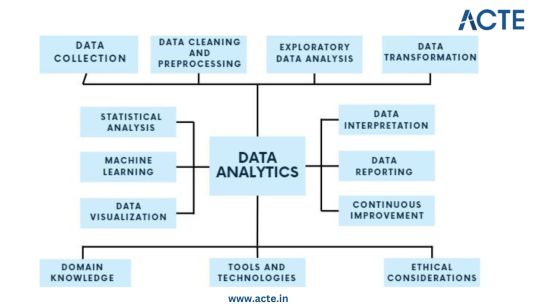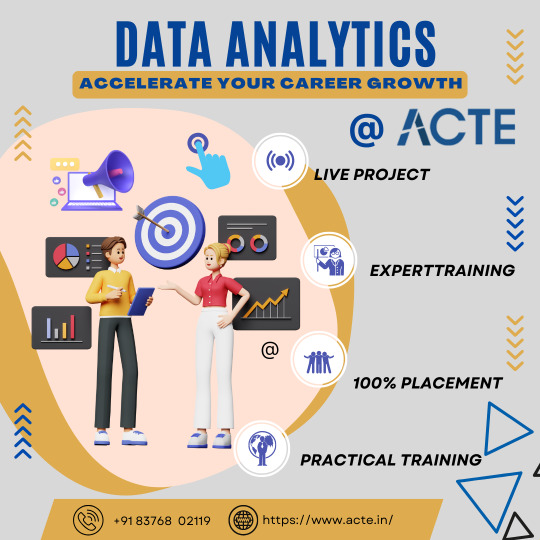#big data analysis
Link
This guide provides valuable insights into the benefits of having a portfolio and offers a range of significant projects that can be included to help you get started or accelerate your career in data science. Download Now.
#database#data mining#data warehousing#data#data science#data scientist#data analysis#data analyst#Big Data Analysis#data processing#data projects
5 notes
·
View notes
Photo

Get ready for the era of big data. Know about its importance in the field of manufacturing & how its bringing efficiency in the sector along with profit gains.
https://www.dasca.org/world-of-big-data/article/big-data-in-manufacturing
2 notes
·
View notes
Text
What are the best data analytics courses?
In today's data- driven folks, the capability to dissect and decide perceptivity from vast quantities of information is a largely sought- after skill. Whether you are a freshman looking to dive into the instigative field of data analytics or an educated professional aiming to upskill, chancing the stylish data analytics courses is essential to boost your career.
Introductions that have been involved in the data analysis process include data mining, operation, statistics, and donation of data. The very first step is extracting the data from various sources like huge databases, textbooks, detector data, etc. Using the concept of ETL (extract, transform, load), raw data is converted into a manageable format. This process is called data mining and is the most crucial step in the channel. Data warehousing or operation is the next step in the analysis that implements the databases by deriving.
To embark on this informational trip, I have curated a collection of top- notch data analytics courses that offer unique perspectives, interactive literacy gests, and comprehensive knowledge.
Data analytics:
Data analytics can help small businesses in several ways. By understanding data analytics, businesses can make better opinions about where to allocate their coffers and how to price their products or services. also, data analytics can help businesses identify trends and understand their client base. Data analytics software can track and dissect data, allowing you to produce practicable reports and dashboards. However, read our companion to the stylish data analytics tools and software available moment if you ’re looking for a dependable result.
Let's explore these courses together and discover which bones reverberate with your literacy style and pretensions. Data analytics is the part of a data critic to find patterns in the information present to Ameliorate performance and effectiveness. They also need to work through a complete analysis of the channel of data. Which means there can be multitudinous ways to dissect data.
These are the top online courses for data analysis.
1. Data Analytics with R and Excel
As a data analyst, Excel is a powerful tool that can help you organize, analyze, and visualize data. Here are some key skills and techniques you can use in Excel for data analysis: Excel provides various functions and tools to clean and transform your data. You can use functions like TRIM, CLEAN, and SUBSTITUTE to remove extra spaces, and special characters, or replace text. Tools like data filters and conditional formatting can help you identify and handle missing or inconsistent data.
2. Big Data Analysis with Python
Community Support Python has a large and active community that supports and contributes to the development of colourful data wisdom libraries and tools. This community has produced numerous useful libraries, including Pandas, NumPy, matplotlib, and SciPy, which are extensively used in data science.
3. Python for data analytics
Thanks to Python's focus on simplicity and readability, it boasts a gradational and low literacy wind. This ease of literacy makes Python an ideal tool for neophyte programmers. Python offers programmers the advantage of using smaller lines of law to perform tasks than is demanded when using aged languages. In other words, you spend further time playing and lower time working law.
4. Business Analytics specialization with Tableau
A powerful BI tool, Tableau is the second most popular one from our survey. It helps extract and gather data stored in multiple locations and comes with an intuitive drag-and-drop interface. Tableau makes data across departments readily available for data engineers and managers to create useful dashboards.
Conclusion:
Data analyst boot camps are suitable for individuals who want to kick-start their careers in data analysis or professionals seeking to upskill and transition into a data-related role. By providing a condensed and focused learning experience, boot camps aim to prepare participants for entry-level data analyst positions or provide them with a strong foundation to pursue further studies or certifications in the field of data analytics. Excel provides built-in data analysis tools, such as regression analysis, descriptive statistics, and goal-seeking. These tools can help you perform advanced analysis, such as identifying trends, finding correlations, forecasting, and performing what-if scenarios.
Here's how you can get started!
1 note
·
View note
Text
Kyligence to Present "Building a Unified Metrics Store" at Gartner Data & Analytics Summit 2023
Kyligence, a global provider of Big Data Analysis and Metrics platforms, has announced its participation in the Gartner Data & Analytics Summit 2023 in Orlando, Florida. The company’s co-founder and CEO, Luke Han, will present a session titled “Building a Unified Metrics Store” on Wednesday, March 22, at 11:30 AM EDT in Swan Ballroom 10.
The session aims to address the low efficiency and…

View On WordPress
#Big Data Analysis#Customer Behavior#Data & Analytics Summit#Gartner#KPIs#Kyligence#Luke Han#Metrics Platforms#Regulatory Compliance Metrics#unified metrics store
0 notes
Text
The Best Of 2023 On Medium About Big Data, AdTech, & More | CUBERA
Cubera is a data company that is revolutionizing AdTech and Big Data Analytics through the data value share model, in which customers entrust us with their data. Cubera has developed the art of understanding, processing, extracting, and analyzing the data that has been entrusted to us. To stay up to date, follow us on Medium.
Visit - https://medium.com/@cubera_inc
0 notes
Text
Big Data Analysis
We are living in the age of technology. Nowadays with the usage of the internet, you could easily learn how to make a motorbike or even how to fly an airplane.
Without data analysis, a company is blind and deaf. With the increase in the use of the internet and technology, companies are trying to use this information to maximize their revenues.
Read: Business Data Analysis and Solutions | VCQRU
0 notes
Text

Deep Tech is an emerging technology that has the potential to transform our lives. It is also changing the way we work, play, shop, travel, and live.
Visit: https://www.networkscience.ai/trends/deep-tech-innovation/
#technology#Deep Tech Innovation#Zero code application Development#Machine Learning#Augmented Reality#Cybersecurity UK#Big Data Analysis#ai and innovation
0 notes
Text
Well. Since the Terrible Poll about knots in Omegaverse and A/B/O got a heck of a lot more attention than I was expecting, and since at least three people said I should do more polling, and since I really only needed one to convince me...
The Terrible Poll - Extended Edition - Biology
Wait, look at me. No, seriously, look at me. I am a nerd and a child of scientists. This is 175 questions long.
That is Many, and this is only about biology and physical stuff. It is as broad as I could, but includes places to add things I missed. It is written as clinically as I could manage, and you don't need to input your email, but there are some illustrations.
I'm working on a second one about society.
This is not a poll asking you what you see the most, or what is popular. This is about Your Interpretation of the concept. There are no wrong answers here.
Take this, share it, get it into other fandoms, take it to reddit, brave souls can post it to facebook or twitter. I need as many data points as I can get because if I am going to do all of this work, I am going to create something at the end of this, so I want the dataset to be solid. Definitely a breakdown of trends and outliers into readable graph or infographic form. Probably an analytic essay. Potentially a science based concept with evolutionary reasoning that I've developed.
#the terrible poll#omegaverse#Alpha/beta/omega#fanfiction#ao3#Please spread this and share it#if all I get are answers from my fandoms#the data is far less useful or interesting#and yes#I am a big nerd#who likes to understand trends#and who enjoys data analysis#even when answers on the last one made me 0.0#I wasn't judging you#I was astonished by the breadth of fandom and humanity
1K notes
·
View notes
Link
PCA (Principle Component Analysis) is a commonly used technique in biomedical research to identify similarities and differences between groups of samples. Though conventional PCA is a great tool, it still has some limitations in visualizing and quantifying batch effects; therefore, to overcome these limitations, researchers from the Department of Bioinformatics and Computational Biology, The University of Texas MD Anderson Cancer Center, USA, developed PCA-Plus.
It is an enhanced version of conventional PCA with advanced and additional features for improved diagnosis, detection, and quantification of differences in a group of samples. It appears to be a useful and valuable tool for researchers working on large datasets, particularly in the field of bioinformatics and related areas, where batch effects and group differences are important considerations.
To untangle the complexities of datasets with many variables, PCA (Principal Component Analysis) is an important tool to help researchers in data analysis. PCA is a powerful statistical technique that sorts data into a simpler and much more understandable form. It identifies the main components that explain the most variance in the given dataset. PCA reduces the complexity of your data while preserving the essential information by focusing on the main components. This makes it easier to visualize trends and patterns, dimensionality reduction, feature extraction, and anomaly detection. It has been used in a wide variety of contexts, for example, image processing and compression, characterization of molecular dynamics, linguistic information retrieval, and assessment of batch effects.
Continue Reading
32 notes
·
View notes
Photo

Automated Data Analytics: How, When & Why?
https://www.dasca.org/world-of-big-data/article/automated-data-analytics-how-when-and-why
Automating Data Analytics is the best way to save on cost, time & efforts while making informed decisions that are profitable for you & your organisation.
0 notes
Text
For anyone currently in school or recently in school

I am doing a few guest lectures at some of the universities in my state and working on my presentation. Curious if anyone has any recommendations of topics they really enjoyed from a past guest speaker that isn't major/field-specific?
#college#college student#studying#studyblr#school#university#accounting#finance#consulting#data analytics#data analysis#data visualization#big data#data
22 notes
·
View notes
Text
In the subject of data analytics, this is the most important concept that everyone needs to understand. The capacity to draw insightful conclusions from data is a highly sought-after talent in today's data-driven environment. In this process, data analytics is essential because it gives businesses the competitive edge by enabling them to find hidden patterns, make informed decisions, and acquire insight. This thorough guide will take you step-by-step through the fundamentals of data analytics, whether you're a business professional trying to improve your decision-making or a data enthusiast eager to explore the world of analytics.

Step 1: Data Collection - Building the Foundation
Identify Data Sources: Begin by pinpointing the relevant sources of data, which could include databases, surveys, web scraping, or IoT devices, aligning them with your analysis objectives.
Define Clear Objectives: Clearly articulate the goals and objectives of your analysis to ensure that the collected data serves a specific purpose.
Include Structured and Unstructured Data: Collect both structured data, such as databases and spreadsheets, and unstructured data like text documents or images to gain a comprehensive view.
Establish Data Collection Protocols: Develop protocols and procedures for data collection to maintain consistency and reliability.
Ensure Data Quality and Integrity: Implement measures to ensure the quality and integrity of your data throughout the collection process.
Step 2: Data Cleaning and Preprocessing - Purifying the Raw Material
Handle Missing Values: Address missing data through techniques like imputation to ensure your dataset is complete.
Remove Duplicates: Identify and eliminate duplicate entries to maintain data accuracy.
Address Outliers: Detect and manage outliers using statistical methods to prevent them from skewing your analysis.
Standardize and Normalize Data: Bring data to a common scale, making it easier to compare and analyze.
Ensure Data Integrity: Ensure that data remains accurate and consistent during the cleaning and preprocessing phase.
Step 3: Exploratory Data Analysis (EDA) - Understanding the Data
Visualize Data with Histograms, Scatter Plots, etc.: Use visualization tools like histograms, scatter plots, and box plots to gain insights into data distributions and patterns.
Calculate Summary Statistics: Compute summary statistics such as means, medians, and standard deviations to understand central tendencies.
Identify Patterns and Trends: Uncover underlying patterns, trends, or anomalies that can inform subsequent analysis.
Explore Relationships Between Variables: Investigate correlations and dependencies between variables to inform hypothesis testing.
Guide Subsequent Analysis Steps: The insights gained from EDA serve as a foundation for guiding the remainder of your analytical journey.
Step 4: Data Transformation - Shaping the Data for Analysis
Aggregate Data (e.g., Averages, Sums): Aggregate data points to create higher-level summaries, such as calculating averages or sums.
Create New Features: Generate new features or variables that provide additional context or insights.
Encode Categorical Variables: Convert categorical variables into numerical representations to make them compatible with analytical techniques.
Maintain Data Relevance: Ensure that data transformations align with your analysis objectives and domain knowledge.
Step 5: Statistical Analysis - Quantifying Relationships
Hypothesis Testing: Conduct hypothesis tests to determine the significance of relationships or differences within the data.
Correlation Analysis: Measure correlations between variables to identify how they are related.
Regression Analysis: Apply regression techniques to model and predict relationships between variables.
Descriptive Statistics: Employ descriptive statistics to summarize data and provide context for your analysis.
Inferential Statistics: Make inferences about populations based on sample data to draw meaningful conclusions.
Step 6: Machine Learning - Predictive Analytics
Algorithm Selection: Choose suitable machine learning algorithms based on your analysis goals and data characteristics.
Model Training: Train machine learning models using historical data to learn patterns.
Validation and Testing: Evaluate model performance using validation and testing datasets to ensure reliability.
Prediction and Classification: Apply trained models to make predictions or classify new data.
Model Interpretation: Understand and interpret machine learning model outputs to extract insights.
Step 7: Data Visualization - Communicating Insights
Chart and Graph Creation: Create various types of charts, graphs, and visualizations to represent data effectively.
Dashboard Development: Build interactive dashboards to provide stakeholders with dynamic views of insights.
Visual Storytelling: Use data visualization to tell a compelling and coherent story that communicates findings clearly.
Audience Consideration: Tailor visualizations to suit the needs of both technical and non-technical stakeholders.
Enhance Decision-Making: Visualization aids decision-makers in understanding complex data and making informed choices.
Step 8: Data Interpretation - Drawing Conclusions and Recommendations
Recommendations: Provide actionable recommendations based on your conclusions and their implications.
Stakeholder Communication: Communicate analysis results effectively to decision-makers and stakeholders.
Domain Expertise: Apply domain knowledge to ensure that conclusions align with the context of the problem.
Step 9: Continuous Improvement - The Iterative Process
Monitoring Outcomes: Continuously monitor the real-world outcomes of your decisions and predictions.
Model Refinement: Adapt and refine models based on new data and changing circumstances.
Iterative Analysis: Embrace an iterative approach to data analysis to maintain relevance and effectiveness.
Feedback Loop: Incorporate feedback from stakeholders and users to improve analytical processes and models.
Step 10: Ethical Considerations - Data Integrity and Responsibility
Data Privacy: Ensure that data handling respects individuals' privacy rights and complies with data protection regulations.
Bias Detection and Mitigation: Identify and mitigate bias in data and algorithms to ensure fairness.
Fairness: Strive for fairness and equitable outcomes in decision-making processes influenced by data.
Ethical Guidelines: Adhere to ethical and legal guidelines in all aspects of data analytics to maintain trust and credibility.

Data analytics is an exciting and profitable field that enables people and companies to use data to make wise decisions. You'll be prepared to start your data analytics journey by understanding the fundamentals described in this guide. To become a skilled data analyst, keep in mind that practice and ongoing learning are essential. If you need help implementing data analytics in your organization or if you want to learn more, you should consult professionals or sign up for specialized courses. The ACTE Institute offers comprehensive data analytics training courses that can provide you the knowledge and skills necessary to excel in this field, along with job placement and certification. So put on your work boots, investigate the resources, and begin transforming.
21 notes
·
View notes
Text
First time that I'm seeing in practice why Python is so widely used in Data Analysis. I have an Excel sheet with 8 million rows, that's impossible to open. I can't analyze anything without the program crashing.
I have even more respect for Python now.
33 notes
·
View notes
Text
Get To Know About Us, Get To Know About Cubera On Crunchbase!
Using the data value share model, in which clients entrust us with their data, Cubera is a data firm that is reinventing AdTech and Big Data Analytics. In order to comprehend, process, extract, and analyze the data that has been entrusted to us, Cubera has mastered this art. Follow us on Crunchbase to stay up to date.
Visit- https://www.crunchbase.com/organization/cubera-0218
#cubera#big data analysis#big data companies in india#big data analytics#adtech#insight driven organization
0 notes